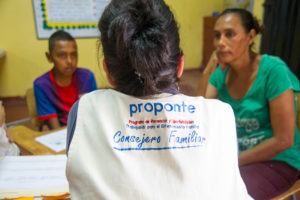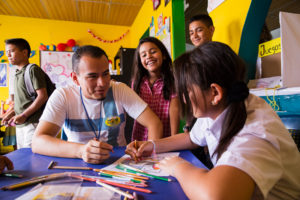Positive youth development succeeds in D.C. & beyond
By Jillian SlutzkerMay 2, 2016
There are three things young people wanted and needed when they first walked through the doors of The Latin American Youth Center in 1974 Washington, D.C., said the center’s President and CEO Lori Kaplan. Jobs. Education. And connection.
Today, through a network of services and opportunities in these and other areas—including mental health, housing and more—the center supports more than 4,000 young people each year in their transitions to successful adulthood.
It is “a whole system that really exemplifies everything we’ve been talking about in positive youth development,” said Bonnie Politz, Senior Youth Consultant for Creative Associates International, speaking at the Society for International Development’s Youth in Development Workgroup meeting on April 26 at the Latin American Youth Center.
A positive youth development approach focuses on building young peoples’ skills and assets and engaging them as key actors in their own development and youth programming.
Now at the forefront of the U.S. Agency for International Development’s youth programming, this type of an approach emphasizes building healthy relationships with caring adults and role models; empowering youth and seeking their contributions; and providing safe spaces and integrated support systems for young people across different areas of their lives.
“It is not just a question of what happens to young people within the doors of a youth center, but what happens to young people throughout their lives,” said Kristen Brady, Director of the Youth Department at FHI360 and Co-Chair of the workgroup.
Creative’s Politz urged that practitioners think about youth development across an integrated spectrum, including workforce readiness, education, health and mental health, family systems and more, rather than as siloed sectors with disparate goals.
A toolkit of opportunities for different youth & risk levels

In any given community, different youth will face very different levels of risk. A positive youth development approach means adapting and tailoring interventions to meet the particular needs of each young person, said presenters.
“You just have to have enough opportunities in your toolkit of options,” said Kaplan, explaining that an out-of-school and out-of-work young person will require more intensive educational and workforce support services than an A-level student who may instead need help navigating higher education options.
In Latin America, for example, where gang violence runs high, less than 1 percent of youth will actually become perpetrators of this violence. A one-size-fits-all approach will not succeed at reaching those youth most at-risk of joining these groups or those who are already involved.
Rather, programs like secondary prevention family counseling that are tailored to reduce risk factors among this high-risk population and reintegration programs for former juvenile offenders will be most effective, explains Enrique Roig, Director of Citizen Security at Creative.
“We are getting much better at identifying those most at-risk youth for gang involvement or violent behavior and matching them up with positive youth development services, and being able to measure the impact and reduction in risk factors,” says Roig.
Meanwhile, a larger youth population living in an at-risk areas will benefit from access to a safe space and a holistic network of opportunities including vocational trainings, mentorship, and life skills courses provided by neighborhood Outreach Centers.
Through 200 Outreach Centers in El Salvador, Guatemala, Honduras and Panama, more than 70,000 at-risk youth in the most challenging neighborhoods have benefited from these services and access to a safe place to grow and learn away from the violence. The Outreach Centers were launched by Creative and supported by USAID, the private sector, local organizations and municipal governments.
Long-term support & a caring adult

The challenges a young person faces as a 14-year-old will be very different from what she encounters as a teen mother, or a twenty-something job seeker, explained the presenters. Youth need long-term support to surmount these challenges throughout their transitions to positive adulthood
A caring adult or role model has proven to be instrumental in helping youth achieve this successful transitions, said Politz.
“We’re developing all through our lives,” she added, noting that youth face episodic and ongoing problems, like a family crisis or poverty, all of which they can more successfully navigate with the guidance of a caring adult over time.
In Creative’s Proponte Más program in Honduras, for example, trained and certified family counselors work in close partnership with high-risk youth and their families to establish and build these positive relationships that can help reduce youth risk factors.
At the Latin American Youth Center, the Promotor Pathway program pairs caring adult mentors with young people using “a long-term relationship-based strategy to meet the multiple needs of the region’s most vulnerable youth.”
These “promotors” support the youth as they navigate crises including substance abuse or the criminal justice system and help to connect them to the appropriate support services. Long-term support is a critical element in the program’s success.
“We were never about opening and closing a case,” said Kaplan. “It’s about support systems in communities where young people can grow and thrive.”

